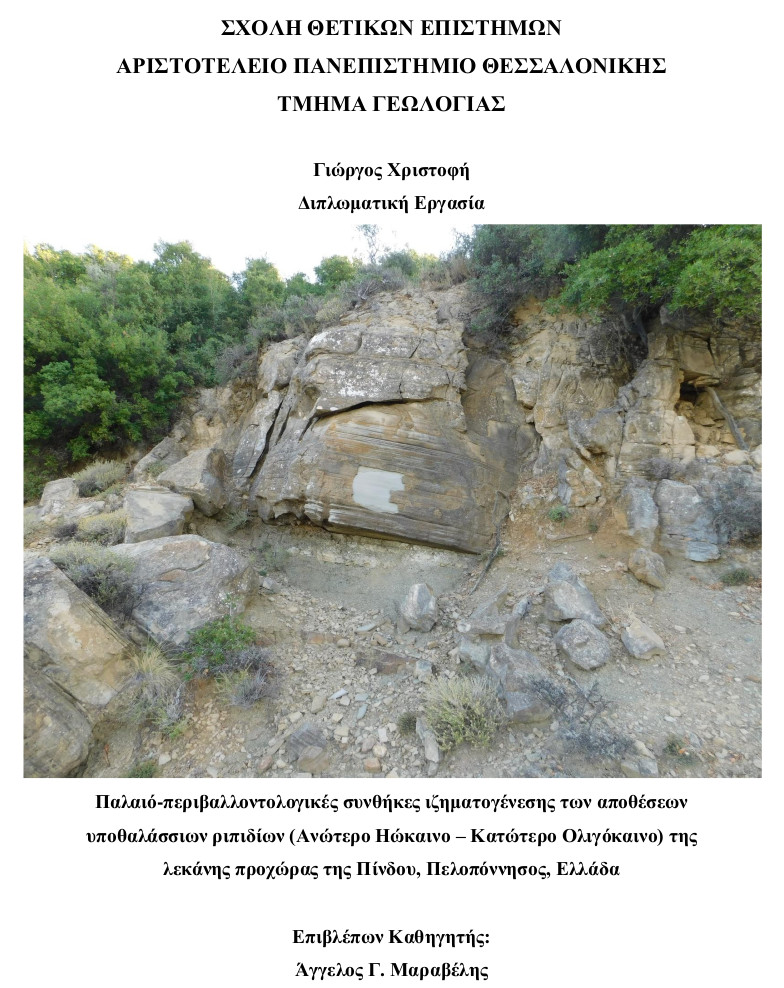
Παλαιο-περιβαλλοντικές συνθήκες ιζηματογένεσης των αποθέσεων υποθαλάσσιων ριπιδίων (Ανωτέρου Ηωκαίνου - Κατώτερου Ολιγοκαίνου της λεκάνης προχώρας της Πίνδου, Πελοπόννησος, Ελλάδα = Paleoenviromental conditions during the deposition of the Upper Eocene - lower Oligocene sub-marine fan deposits (Pindos foreland Basin, Peloponnese, Greece).
Περίληψη
The present studyrefers to paleoenviromental conditions during the sedimentationof theLate Eocene toEarly Oligocene submarine fans deposits in Pindos foreland Basin in Peloponnese. More specifically, the study area consists of three sections, Finikounda, Tritea and Hrisovitsi section.The geochemical analysis was conducted,by using ICP-OES (major elements) and ICP-MS (trace elementsand REE) and revealed the geochemical signatures of the studied deposits. The results of the analysis suggest generally oxic conditions, along with dry and warm paleoclimatic conditions. Further, the results suggest increased levels of salinity and sediment deposition in a fully marine depositional environment.
Πλήρες Κείμενο:
PDFΑναφορές
• Adams, J.A.S., Weaver, C.E., 1958. Thorium to uranium ratios as indicators of sedimentary processes e examples of the concept of geochemical facies. Am. Assoc. Pet. Geol. Bull. 42, 387e430.
• Algeo, T.J.; Liu, J. A re-assessment of elemental proxies for paleoredox analysis. Chem. Geol. 2020, 540, 119549.
• Algeo, T.J.; Liu, J. A re-assessment of elemental proxies for paleoredox analysis. Chem. Geol. 2020, 540, 119549.
• Bhatia MR (1983) Plate tectonics and geochemical composition of sandstones. J Geol 91(6):611–627.
• Bhatia MR, Crook KAW (1986) Trace elements characteristics of graywackes and tectonic setting discrimination of sedimentary basins. Contrib Mineral Petrol 92:181–193.
• Cao, J.; Yang, R.; Yin,W.; Hu, G.; Bian, L.; Fu, X. Mechanism of Organic Matter Accumulation in Residual Bay Environments: The Early Cretaceous Qiangtang Basin, Tibet. Energy Fuels 2018, 32, 1024–1037.
• Cao, J.;Wu, M.; Chen, Y.; Hu, K.; Bian, L.;Wang, L.; Zhang, Y. Trace and rare earth element geochemistry of Jurassic mudstones in the northern
Qaidam Basin, northwest China. Geochemistry 2012, 72, 245–252.
• Chivas, A.R., Deckker, P., Shelley, J.M.G., 1986. Strontium content of Ostracoda indicates paleosalinity. Nature 316, 251–253.
• Cox, R., Lowe, D.R., Cullers, R., 1995. The influence of sediment recycling and basement composition on evolution of mudrock chemistry in the southwestern United States. Geochem. Cosmochim. Acta 59, 2919–2940.
• Custodio, E., 2002. Aquifer overexploitation: what does it mean? Hydrogeol. J. 10 (2), 254-277.
• Fedo, C.M., Nesbitt, H.W., Young, G.M., 1995. Unraveling the effects of potassium metasomatism in sedimentary rocks and paleosols, with implications for paleoweathering conditions and provenance. Geology 23 (10), 921–924.
• Feng, X.L.; Fu, X.G.; Tan, F.W.; Chen, W.B. Sedimentary environment characteristics of Upper Carboniferous Cameng Formation in Kongkong Chaka Area of Northern Qiangtang Basin, Tibet. Geoscience 2014, 28, 953–961.
• Fu, X.;Wang, J.; Chen,W.; Feng, X.; Wang, D.; Song, C.; Zeng, S. Elemental geochemistry of the early Jurassic black shales in the Qiangtang Basin, eastern Tethys: Constraints for palaeoenvironment conditions. Geol. J. 2016, 51, 443–454.
• Hatch, J.R., Leventhal, J.S., 1992. Relationship between inferred redox potential of the depositional environment and geochemistry of the Upper Pennsylvanian (Missourian) Stark shale member of the Dennis Limestone, Wabaunsee County, Kansas, USA. Chem. Geol. 99, 65–82.
• Hu, J.; Li, Q.; Li, J.; Huang, J.; Ge, D. Geochemical characteristics and depositional environment of the Middle Permian mudstones from central Qiangtang Basin, northern Tibet. Geol. J. 2016, 51, 560–571.
• Jones, B.,Manning, D.C.,1994.Comparison of geochemical indicesused for the interpretation of paleo-redox conditions in ancient mud stones. Chem. Geol. 111,111–129.
• Madhavaraju,J.,Lee,Y.I.,2009.Geochemistry of the dalmiapuram formation of the uttatur group(Early Cretaceous), Cauvery basin, southeastern India: implications on provenance and paleoredox conditions.Rev.Mex.Cienc.Geol.26, 380–394.
• McLennan SM, Hemming S, McDaniel DK, Hanson GN (1993) Geochemical approaches to sedimentation, provenance and tectonics. In: Johnsson MJ, Basu A (eds) Processes controlling the composition of clastic sediments. Geological Society of America Special Paper 284, pp 21–40.
• McLennan, S.M., 2001. Relationships between the trace element composition of sedimentary rocks and upper continental crust. G-cubed 2. Paper number 2000GC000109.
• Minyuk, P.S., Brigham-Grette, J., Melles, M., Borkhodoev, V.Y., Glushkova, O.Y., 2007. Inorganic geochemistry of El’gygytgyn Lake sediments (northeastern Russia) as an indicator of paleoclimatic change for the last 250 kyr. J. Paleolimnol. 37, 123–133.
• Nagarajan,R.,Madhavaraju,J.,Nagendra,R.,Armstrong-Altrin,J.S.,Moutte,J.,2007. Geochemistry of Neoproterozoic shales of Rabanpalli Formation, Bhimabasin, northern Karnataka, southern India: implications for provenance and paleoredox conditions.Rev.Mex.Cien.Geol.24,150–160.
• Nesbitt, H.; Young, G.M. Early Proterozoic climates and plate motions inferred from major element chemistry of lutites. Nature 1982, 299, 715–717.
• Pattan, J.N.,Pearce,N.J.G.,Mislankar,P.G.,2005.Constraints in using Cerium- anomaly of bulk sediments as an indicator of paleobottom water redox environment: a case study from the Central Indian Ocean Basin.Chem.Geol.221, 260–278.
• Pisarzowska, A.; Rakoci´ nski, M.; Marynowski, L.; Szczerba, M.; Thoby, M.; Paszkowski, M.; Perri, M.C.; Spalletta, C.; Schönlaub, H.P.; Kowalik, N.; et al. Large environmental disturbances caused by magmatic activity during the Late Devonian Hangenberg Crisis. Glob. Planet. Chang. 2020, 190, 103155.
• Roser BP, Korsch RJ (1986) Determination of tectonic setting of sandstone–mudstone suites using SiO2 and K2O/Na2O ratio. J Geol 94:635–650.
• Roy, D.K.; Roser, B.P. Climatic control on the composition of Carboniferous-Permian Gondwana sediments, Khalaspir basin, Bangladesh. Gondwana Res. 2013, 23, 1163–1171.
• Schwab FL (1975) Framework mineralogy and chemical composition of continental margin-type sandstone. Geology 3:487–490.
• Wang, Z.; Fu, X.; Feng, X.; Song, C.;Wang, D.; Chen,W.; Zeng, S. Geochemical features of the black shales from the Wuyu Basin, southern Tibet: Implications for palaeoenvironment and palaeoclimate. Geol. J. 2017, 52, 282–297.
• Wei, W., Algeo, T.J., 2020. Elemental proxies for paleosalinity analysis of ancient shales and mudrocks. Geochim. Cosmochim. Acta 287, 341–366.
• Wignall, P.B., Twitchett, R.J., 1996. Oceanic anoxia and the end Permian mass extinction. Science 272, 1155e1158.
• Wignall, P.B.,Myers,K.J.,1988.Interpreting the benthic oxygen levels in mud rocks, a newapproach.Geology16,452–455.
• Zimmermann U, Bahlburg H (2003) Provenance analysis and tectonic setting of the Ordovician clastic deposits in the southern Puna Basin, NWArgentina. Sedimentology 50:1079–1104.
Εισερχόμενη Αναφορά
- Δεν υπάρχουν προς το παρόν εισερχόμενες αναφορές.
